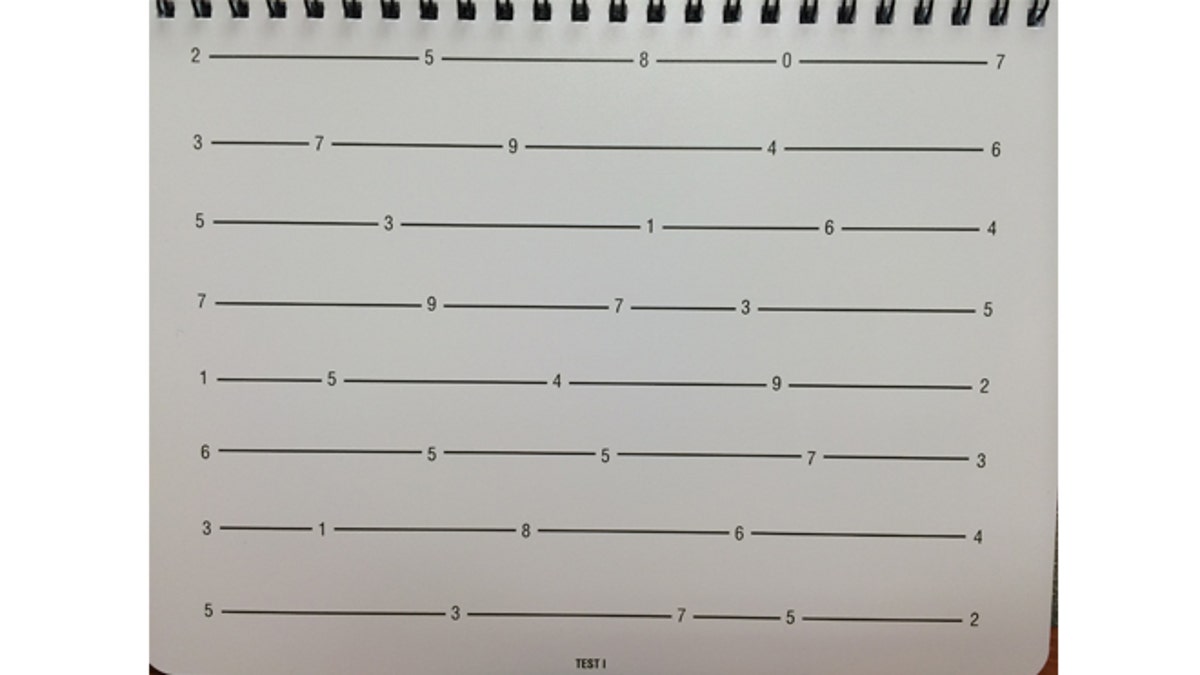
The King-Devick test, shown here, requires athletes to read rows of numbers during a timed test to determine whether or not they have experienced a concussion. (Image courtesy of NYU.)
As awareness about the dangers of concussions grows, greater urgency has been placed on detecting head injuries in athletes as early as possible – in order to prevent injured players from risking grave injury by returning to a game.
New research presented at the American Academy of Neurology's 66th Annual Meeting in Philadelphia indicates that a quick vision test, known as the King-Devick test, combined with a series of other simple tests, could yield near-perfect concussion detection rates on the sidelines of a game.
Dr. Laura Balcer, professor and vice chair of neurology at New York University’s Langone Medical Center, said vision tests can be an important tool for detecting neurological issues.
“Since the visual pathways take up more than half of the brain’s pathways, we [thought] including a vision test could help identify concussions on the sidelines,” Balcer told FoxNews.com.
The King-Devick test requires athletes to read lines of single-digit numbers on a series of three index cards. Each of the three cards is progressively harder to read, as the numbers become staggered or grouped together – but on average, the test takes a healthy collegiate athlete about a minute to complete.
“Concussion affects vision in so many ways— people describe blurred vision, double vision, they can have trouble coordinating their eyes and head, trouble focusing, bringing the eyes together,” Balcer said. “[It] can manifest through reading, which is why one of the ways to capture visual symptoms is rapid number naming.”
In a retrospective study of 217 athletes at the University of Florida, each athlete underwent a series of concussion tests at the beginning of the season to determine their baseline scores. In addition to the King-Devick test, the athletes took a Standardized Assessment of Concussion (SAC) test, which consists of cognitive challenges such as remembering a series of words, or repeating back sequences of numbers. They also took the Balance Error Scoring System (BESS) test, which measures athletes’ ability to balance.
Overall, the King-Devick test proved to be an effective means of detecting concussion throughout the course of the season.
“We found 79 percent of athletes who had a concussion, and sometimes they don’t report it right away, had a worsening of the score on the King-Devick test compared to preseason,” Balcer said.
And when researchers combined the results of the King-Devick test with results of the SAC test and the BESS test, the three assessments together provided a 100 percent success rate in identifying concussions among athletes.
“We believe a composite, or a group of tests, that can capture the major things going on with concussion – balance, cognitive and vision – could allow us to identify more (injured) athletes,” Balcer said.
The researchers hope to someday create a ‘toolbox’ of concussion detection tests that could be utilized in players all the way from youth leagues through the professional level. Currently, Balcer and her colleagues are conducting a study on youth hockey players, to assess whether parent coaches and volunteers are able to successfully administer these tests to injured athletes on the sidelines of games.
Furthermore, as more research is done into potential treatments for traumatic brain injuries, the researchers noted that early detection will become even more critical.
“We don’t have those treatments yet, but one of the goals of developing tests is not only diagnosis but, can they show if a therapy works?” Balcer said. “So once we develop therapies it would be helpful to have a toolbox of tests [to assess how those therapies work]."
